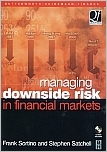| |||||
• polskie
• Zamów informacje o nowościach z wybranego tematu • kontakt |
MANAGING DOWNSIDE RISK IN FINANCIAL MARKETSSATCHELL S.wydawnictwo: BH, 2001, wydanie Icena netto: What's the downside? is the oft-used question that captures the notion of financial risk. The degree of risk involved in any financial decision depends on what the investor is trying to accomplish. For most financial decisions, there is some rate of return that must be earned at minimum in order to accomplish the goal. We call this the minimal acceptable return, or MAR. Returns below the MAR incur risk of not accomplishing your goal. Returns above the MAR are the reward you get for taking the risk, and every investment decision involves a trade off between risk and return. Managing downside risk is what this book is all about. It is self evident that one cannot manage what one cannot describe. The more accurately we can describe something, the better we can manage it. There are a number of researchers and practitioners around the world who share a common view of how to measure, and therefore, manage downside risk. We are very pleased to be able to share with you their wealth of knowledge on this important subject. To help you implement the knowledge you will gain from their efforts, this book contains a CD with software that will enable you to calculate downside risk from monthly returns on any portfolio manager. Dr Frank Sortino founded the Pension Research Institute (PRI) in the United States of America in 1980 and has conducted many research projects since, the results of which have been published in leading journals of finance. For several years, he has written a quarterly analysis of mutual fund performance for Pensions & Investments Magazine. Dr Sortino recently retired from San Francisco State University as Professor of Finance to devote full time to his position as Director of Research at the PRI. Dr Stephen Satchell is a Fellow of Trinity College, a Reader in Financial Econometrics at the University of Cambridge and a Visiting Professor at Birkbeck College, City University Business School London and University of Technology, Sydney. He provides consultancy for a range of city institutions in the broad area of quantitative finance. He has published papers in many journals and has a particular interest in risk. 267 pages
Po otrzymaniu zamówienia poinformujemy pocztą e-mail lub telefonicznie, |


